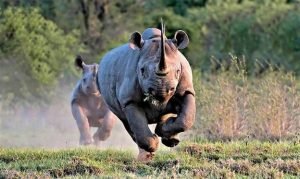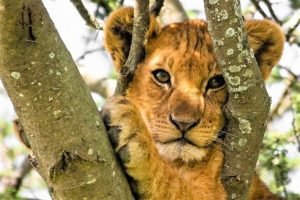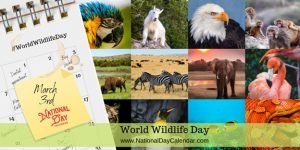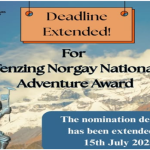
BY DR. RAVINDER PALL SAINI
INDIAN FOREST SERVICE (RETIRED)
MEMBER, BOARD OF MANAGEMENT
FOREST RESEARCH UNIVERSITY,
DEHRADUN
DEHRADUN, 3 MARCH 2023:
World Wildlife Day will be celebrated in 2023 under the theme “Partnerships for wildlife conservation”, honouring the people who are making a difference.

2023 Theme
World Wildlife Day 2023 will be held under the theme “Partnerships for Wildlife Conservation” to celebrate all conservation efforts, from intergovernmental to local scale. Within this theme, the day has a focus on two sub-topics:
- Marine life & oceans – with around 70% of our planet being covered by water, the impact of marine conservation is incredibly important.
- Business & finance – globally, conservation efforts need to be funded and this work needs to be done in collaboration with business – an area that, in the past, has been seen as exploitative and unsustainable. Successful partnerships for conservation must find ways of including business if we are to reverse the loss in biodiversity.

3 March 2023 is also a very special date, as it will also be marking the 50th anniversary of CITES. CITES has stood at the junction of trade and conservation, with Parties to the Convention working with the shared goal of ensuring sustainability of endangered species. CITES has sought to build partnerships and reconcile differences between the groups that are guided and governed by its regulations. At national and local levels, these partnerships have been essential in every country across the globe to focus on the conservation of species and ecosystems.

This year’s theme will provide the opportunity to highlight the people who are making a difference as well as to celebrate the bridge that CITES has been for these partnerships to form, making a significant contribution to sustainability, wildlife and biodiversity conservation.

Partnerships for Conservation are vital, as no organisation, and that includes the UN, can tackle the biodiversity crisis on their own. We have a million species that are threatened with extinction, and it will need all our combined efforts to reverse this. Partnerships bring together people or groups with different levels of experience and expertise, to come up with new ideas and the goal of having impact.
— CITES Secretary-General Ivonne Higuero

The day is about raising awareness about wildlife and educating yourself and others about the diversity and importance of flora and fauna across the world. In other words, it is the celebration of the beautiful biodiversity that exists on our planet.
The United Nations General Assembly ratified World Wildlife Day on December 20th, 2013. Thailand initially proposed the day with the goal of raising awareness of the poor state of the world’s animals and vegetation.

History and significance:
Habitat loss, climate change and poaching are among the most alarming challenges faced by wildlife today all over the world. Poaching and trafficking of wildlife is now the most immediate threat to many species, whether charismatic or less known. This threat needs to be tackled urgently by all the nations. The fate of the world’s wildlife will soon be in the hands of the next generation. The pressing need for increased action to ensure the survival of wildlife in its natural habitats must be taught from generation to generation, and the youth should have the potential to communicate and help in implementation of the conservation goals to a wider society.

The secretariat of the Convention on International Trade in Endangered Species of Wild Fauna and Flora (CITES), in collaboration with other important United Nations organizations, enables the execution of World Wildlife Day.
With 183 Member States, CITES remains one of the world’s most powerful tools for biodiversity conservation through the regulation of trade in wild fauna and flora. It needs to be strengthened with infrastructure and funds to deal with the issues requiring immediate remedial actions across the globe.

Theme of the year 2023:
This year’s theme for World Wildlife Day is “Partnerships for wildlife conservation”, honouring the people who are making a difference.
The themes for previous years were – “Forests and Livelihoods: “Recovering key species for ecosystem restoration” (2022). Sustaining People and Planet” (2021) “Sustaining all life on earth” (2020), “Life below water: for people and planet” (2019), “Big cats – predators under threat” (2018), “Listen to the young voices” (2017).
Getting involved:
Encourage people world over to communicate what you’ve learned with your friends and family.
Spread the word, especially to children and youth. They are the future leaders of wildlife conservation, and they deserve a future where we humans live in harmony with wildlife that share the planet with us. Here are some outreach materials.
Need for promoting Partnerships:
Partnerships operate on a large scale or involve a few universities students or school kids. For some, it could be organizing a school sale cum exhibitions to benefit a conservation group, for others it could be posting photographs online to generate awareness of endangered species. All of them are equally rational.

This forthcoming year, the UN celebrates a special partnership: the 50th anniversary of the Convention on International Trade in Endangered Species of Wild Fauna and Flora (CITES).
This Convention is an international agreement between governments to ensure that international trade in specimens of wild animals and plants does not threaten the survival of the species. Today, it grants varying degrees of protection to more than 37,000 species of animals and plants.
Through the past 50 years, partnerships have been at the heart of CITES, and WWD will celebrate the bridge that CITES has been for these partnerships to form, making a significant contribution to sustainability, wildlife, and biodiversity conservation.
In accordance with this convention, UN agencies, private sector organizations, philanthropies and non-governmental organizations must keep working for conservation, the sustainable use of wildlife and in the fight against illegal trade and the depletion of wildlife.
Supporting existing partnerships and building new ones is significant for the future of life on earth.
(Pics by author and some adapted & shared from World Wildlife UNO site) .

Advertisement:




























Add Comment